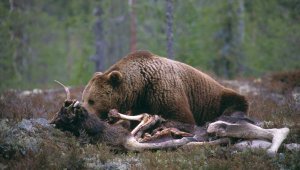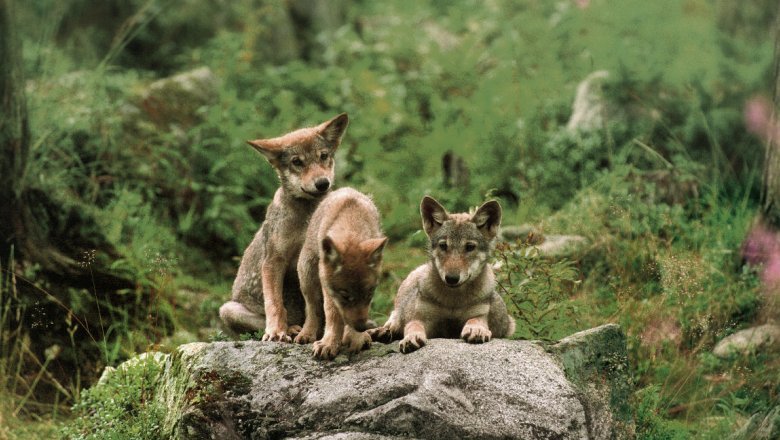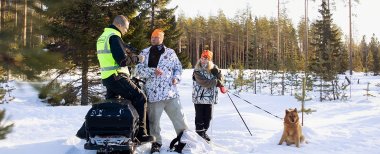Finland's network of large carnivore contact persons has been in place since 1978. There are approximately 2 000 large carnivore contact persons in Finland, most of whom belong to a game management association. The network also includes reindeer herders, border guards and on-the-ground Metsähallitus staff. The contact persons collect and attempt to verify large carnivore sightings made by others in their designated areas. Sightings are collected throughout the year. Each year around 30 000 sightings of different types are logged.
The contact persons enter the sightings into Tassu, a large carnivore sighting system maintained by National Resources Institute Finland (Luke). With this system the sightings are immediately available for research use. Large carnivore sightings entered into the Tassu system may be viewed online at riistahavainnot.fi.
Help from satellites and tracks in the snow
Estimating wolf populations
Wolf population estimates are based on sightings logged into the Tassu sighting system, satellite tracking and knowledge of wolf biology and territorial behaviour. If one knows, for example, the average size of a wolf's territory (approx. 1 100 km2) and knows that a breeding couple, or an alpha couple, will not tolerate strange wolves in their territory, one can combine these bits of knowledge with sighting data and satellite tracking to form an estimate of the number of wolf packs in any given area. The number of individual animals in each pack can be determined by monitoring the animals' tracks in the snow for a long enough period of time. This ensures that the same wolf won't be counted twice.
The size and distribution of a wolf population in a region may be further specified with wildlife censuses where hunters and outdoors enthusiasts work together with researchers from National Resources Institute Finland and spend a day counting the animals in the area. Again, the number of individual animals in each pack is determined by monitoring the animals' tracks in the snow to ensure that the same wolf is not counted twice. These censuses also provide reference data for determining the reliability of population estimates. So far the numbers found in the censuses have been closely in line with the population estimates.
Estimating lynx populations
Assessments of the lynx population are based on litter sighting data recorded by the large carnivore contact persons in the TASSU system. A litter sighting means an observation of a mother together with a cub aged under one year. Separate snow track counts and research projects of the Natural Resources Institute Finland provide complementary data.
To assess the size of the population, the litter sighting data is used to work out the number of separate litters. This figure is multiplied by coefficients determined for different species and areas. The coefficient describes the share of litters out of the total number of lynxes. The share of litters in different areas varies depending on the developmental phase of the lynx population (a spreading, growing or established population), which is why different coefficients are also used.
The method used in Finland has been adapted from the Swedish and Norwegian method for monitoring the lynx population, and it is based on Nordic research findings regarding lynx behaviour and biology. This method was developed for using random litter sightings made over a longer time period. In addition to interpreting the observations, models are used to assess the lynx population and its development. The population model describes population development at a general level and provides 95% confidence intervals for the litter estimate. The prediction model is used to examine the impacts that different levels of hunting pressure have on population development over four years. See the most recent population assessment of the lynx from 2020 (luke.fi, in Finnish)
Estimating bear populations
Bear population estimates are primarily based on sightings of bear litters with cubs under one years of age reported by large carnivore contact persons. The litters move in a relatively small area compared to other bears, and the territories of neighbouring litters do not overlap as much as the territories of other bears living in the same area. Researchers use factors such as the dates of the sightings, the number of cubs, the paw size of the female bear and various distance criteria to estimate the number of individual litters. The distance criteria are based on data on the movement patterns and territory sizes of female bears with cubs acquired via GPS tracking. The estimate of the total number of bears is achieved by multiplying the number of litters by ten.
Bear population estimates for southern and western Finland emphasize the number of lone bears, as litters are quite rare in these parts and the populations consist mostly of young males.
Estimating wolverine populations
Making a wolverine population estimate is challenging and involves more uncertainty than estimating other large carnivore populations. Similarly to the other predator estimates, wolverine estimates are also based on sighting data. In the reindeer herding area the systematic track counts organised by Metsähallitus in cooperation with Sami reindeer herding districts form another vital source of information. Around 3–5 such counts are organised each year. South of the reindeer herding area, valuable wolverine information is also gained from snow track counts coordinated by the Finnish Wildlife Agency. GPS tracking cannot be used in estimating wolverine populations because of the species' biology: the wolverine has a pointed head and the GPS collar would just slip off its neck.


